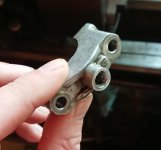I'm trying to center this piece in a 4-jaw chuck so I can re-drill the hole in the center, but I'm not having much luck. I managed to get it down to around .005 once, but I blew it out, had to start over, and haven't gotten anywhere near that since. The boss in the middle has an OD of .480 and the main body is .642 tall, so there's not a lot of room to work with. The boss is machined and as far as I can tell is actually round (I mic'ed it north/south and east/west and got the same number), and the bottom of the piece is flat and wide enough that I can push it down flush on the faceplate of the chuck to help with mounting. I think the biggest problem is that at some point I end up with the low and high spots with one jaw at 5:00 that I can't get the key in without moving the chuck. When I do that, how do I make sure I only move it one dimension and in the right direction? Is there some better trick than just keep fumbling with it and hope it eventually lines up?






 IMHO a job shop lathe without a faceplace is only half tooled at best
IMHO a job shop lathe without a faceplace is only half tooled at best 